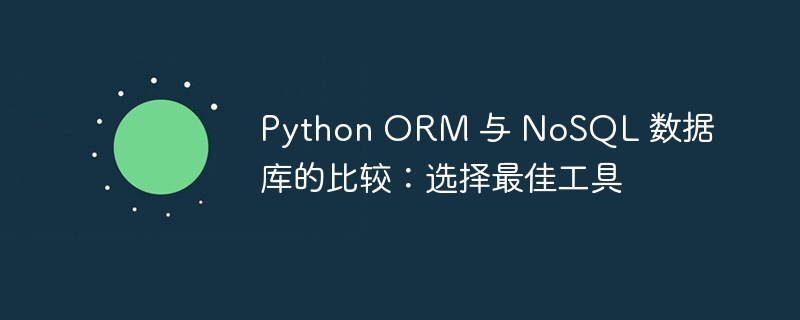
Object Relational Mapping (ORM) is a technology used to map an object model to a relational database, while NoSQL (non-relational) database is designed for the storage and retrieval of unstructured or semi-structured data.
Target Audience
python ORM is mainly aimed at Python developers who use relational databases, while Nosql databases are geared towards processing unstructured or Developer of semi-structured data.
Core Difference
Data model:
- ORM: Based on the relational model, emphasizing the relationship between data.
- NoSQL: Supports multiple data models such as key-value, document, and wide columns.
Database schema:
- ORM: Use a well-defined schema to strictly structure the data.
- NoSQL: Typically has schema flexibility, allowing data to change over time.
Query language:
- ORM: Using Structured Query Language (SQL), optimized for the relational model.
- NoSQL: Use a query language specific to its data model, such as BSON for mongoDB and CQL for Cassandra.
performance:
- ORM: Performance may be poor for complex relational queries.
- NoSQL: Generally has better performance when it comes to processing unstructured data and Big Data sets.
Scalability:
- ORM: Limited horizontal scalability and database replication is required.
- NoSQL: Usually supports horizontal scalability and facilitates processing of large data sets.
Advantage
ORM:
- Easy to use: Automatically handles mapping between objects and databases.
- Code maintainability: Simplify data access code by generating SQL queries.
- Data integrity: Enforce schema constraints to ensure data accuracy.
NoSQL:
- Flexible data model: supports a wide range of data formats.
- High Performance: Designed for processing large data sets and unstructured data.
- Scalability: Easy to scale horizontally and manage large data sets.
Disadvantages
ORM:
- Performance bottleneck: It may be difficult to handle complex relational queries.
- Schema restrictions: The strict nature of the schema may limit data flexibility.
NoSQL:
-
The learning curve is steep: the query language may be different from relational databases.
- Data consistency: Additional solutions may be needed to ensure data consistency across multiple nodes.
Selection criteria
Choosing the best tool depends on the following factors:
-
Data type: The structure and type of data to be stored.
-
Query mode: The frequency and complexity of querying data.
-
Performance requirements: Application requirements for data access speed and scalability.
-
Scalability: Whether the application requires future expansion to handle larger data sets.
-
Cost: Data storage costs associated with maintenance and licensing.
Common Applications
ORM:
- E-commerce: Manage products, customers and orders.
- CRM System: Track customer interactions and manage relationships.
NoSQL:
-
Internet of Things: Stores large amounts of unstructured data from sensors and devices.
- Social Media: Processing of user data, posts and comments.
- BigData Analysis: Analyze and process huge data sets from a variety of sources.
The above is the detailed content of Python ORM vs. NoSQL Databases: Choosing the Best Tool. For more information, please follow other related articles on the PHP Chinese website!






